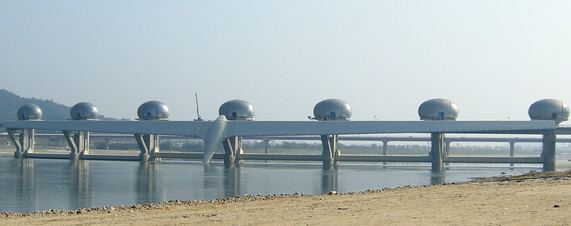 | ||
Similar Weir, Blue House, Andong Dam, Liancourt Rocks, Daecheong Dam | ||
the 1 000 day promise the korean four major rivers restoration project
The Four Major Rivers Restoration Project is the multi-purpose green growth project on the Han River, Nakdong River, Geum River and Yeongsan River in South Korea. The project was spearheaded by former South Korean president Lee Myung-bak and was declared complete on October 21, 2011. It was first announced as part of the “Green New Deal” policy launched in January 2009, and was later included in the government's five-year national plan in July 2009. The government estimated its full investment and funding totaled 22.2 trillion won (Approximately 17.3 billion USD).
Contents
- the 1 000 day promise the korean four major rivers restoration project
- Great four river project korea
- Background
- Policy Direction
- Proactive response against climate change
- Diversification of ways to secure water resources
- Paradigm shift in river management policies
- Utilization of river areas as multipurpose spaces for the co existence of the people and environment
- Implementation of five core challenges to achieve the goal of renewing the territory
- Project time and cost
- Twelve cities and provinces submitted 836 recommendations worth 983 trillion KRW
- Expected Benefits
- Fundamental resolution of floods and water scarcity
- Contribution to sound restoration of the ecosystem
- Increased quality of cultural and leisurely activities and lives
- Local economies revitalized through the Green New Deal
- Promotion of green growth projects
- Bicycles
- Criticism of the project
- Diverting rivers and constructing stepped artificial lakes
- Environmental Impact Assessment without a plan
- Pollutions
- Environmental Damage
- Fraudulent goals
- Increased risk of flooding
- Separation of the people from nature
- Financial risk
- PR issues
- Illegal and undemocratic conventions
- Political Intentions
- References
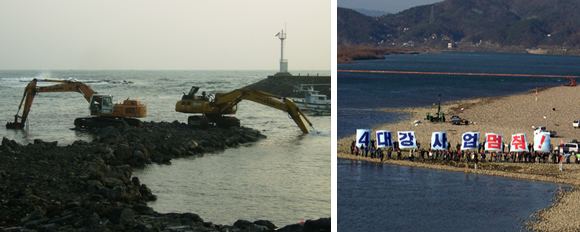
The overall project was broken into three project sets: revitalizing the four rivers, projects on their 14 tributaries and refurbishment for other smaller-sized streams. The project had five key objectives as well: securing abundant water resources to combat water scarcity; implementing comprehensive flood control measures; improving water quality and restoring river ecosystems, creating multipurpose spaces for local residents; and regional development centered on the rivers.
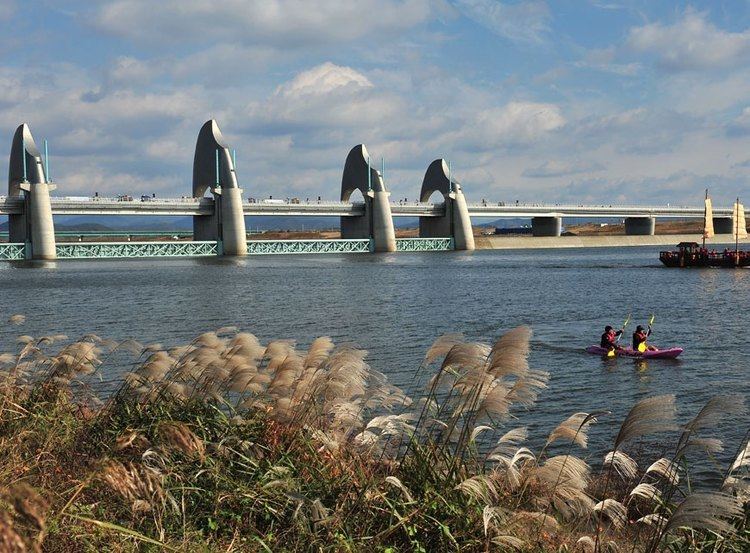
More than 929 km of streams in Korea will be restored as part of the project, with a follow-up operation planned to restore more than 10,000 km of local streams. More than 35 riparian wetlands will also be reconstructed.
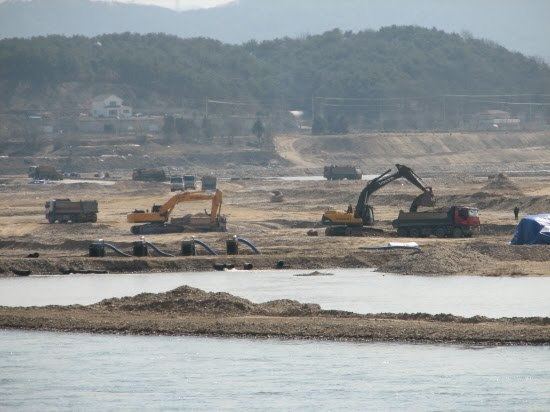
The project was declared complete by President Lee on October 21, 2011. The project was a major recurring story in the media and with the public. It often drew ire and protests over the toll that construction projects could take on the environment, as well as being seen as an extension of Lee's persona as former CEO of Hyundai Engineering & Construction Co. Ltd, nicknamed "The Bulldozer," with his push for swift approval of the project in the National Assembly.
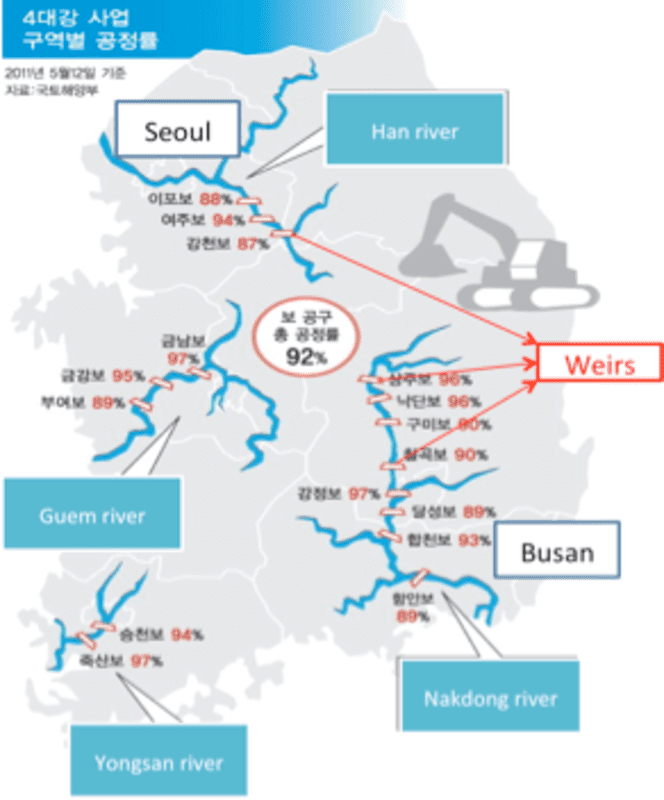
Great four river project korea
Background
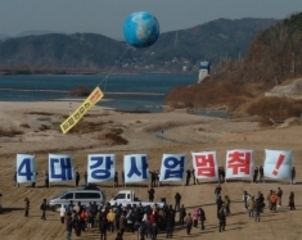
The Four Rivers Restoration Project of Korea was designed to be a packaged project that aims to resolve water-related problems such as floods and droughts and revitalize Korean public spaces near the water. Its projects were carried out simultaneously with heavy investment from multiple government ministries over a 2-year period.
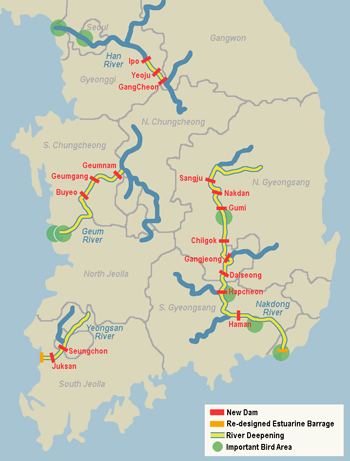
The Korean government estimated about 800 million m3 of water was needed to prevent water scarcity in 2011, and expected the need to grow to one billion m3 in 2016. It was also disclosed that while government recovery expenses due to flooding topped 4.2 trillion won over a decade, average annual investment in flood prevention was only 1.1 trillion won. The government also stated its objective to improve the rivers' water quality, by managing pollutants such as the increase of Biochemical oxygen demand and total phosphorus counts that can result in the waterways' eutrophication.
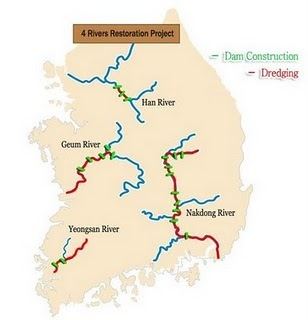
The government also outlined that existing spaces and programs along the rivers for watersports and cultural activities could not keep up with rising demand, a product of Koreans' rising income levels.
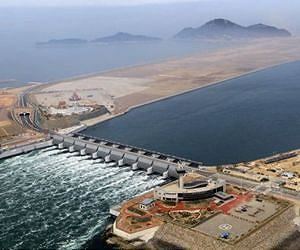
The Four Major Rivers Restoration Project is to contribute to recovering the real economy from the recession through job creation and local economic revitalization.
Policy Direction
The Four Major Rivers Restoration Project has the following policy directions
Proactive response against climate change
Diversification of ways to secure water resources
Paradigm shift in river management policies
Utilization of river areas as multipurpose spaces for the co-existence of the people and environment
Implementation of five core challenges to achieve the goal of renewing the territory
Project time and cost
Twelve cities and provinces submitted 836 recommendations worth 98.3 trillion KRW
Expected Benefits
An opportunity for Korea to position itself as a powerhouse in water resources in the international community
Fundamental resolution of floods and water scarcity
- Increased water storage thanks to dredging sediment and building reservoirs will equip us against droughts.
- Ministry of Land, Transport and Maritime Affairs can be able to secure river maintenance water and strengthen flood control capacity even during droughts by building small sized multipurpose dams and expanding existing agricultural reservoirs.
- Flood damage and recovery expenses will decrease by dredging sediment.
- The down-streams will be protected by retention and riverside reservoirs.
- The reinforcement of old levees will raise the safety in flood control
Contribution to sound restoration of the ecosystem
Increased quality of cultural and leisurely activities, and lives
Local economies revitalized through the Green New Deal
Promotion of green growth projects
- The development of remote sensors will enable real-time monitoring of water pollution, water level, vulnerable areas upon disasters, and facilities such as bridges and dams.
- Digital tours on the culture and historic sites of the four major rivers will be promoted. To this end, the government will support technological development, commercialization, and international standardization of wireless communication, and positioning system.
- Scientific management of resources and environment of the underwater which is difficult to access will become possible by using robots.
- Photovoltaic power generation facilities will be built in riversides that are not submerged.
- The government will construct small hydropower plants when expanding existing reservoirs and agricultural reservoirs.
Bicycles
Companies from the People's Republic of China could benefit a potential sales hike of Made in China bicycles in South Korea, in which 85% of bicycles in South Korea are imported. Other countries can also benefit from this river project as there will be more imports of bicycle parts for bicycle production facilities around South Korea.
Criticism of the project
The Four Major Rivers Project has attracted significant criticism from environmental groups in South Korea and wider international groups such as Friends of the Earth. The criticism has also been seized upon by others who are more generally opposed to the South Korean President, Lee Myung-bak's, administration. The criticism centers on:
The World Wetland Network awards countries for their efforts in wetland management, with Blue Globe Awards to highlight good practices in wetland management and Grey Globe Awards to draw attention to poor practices in wetland management. At their annual Conference of the Parties held on 7 July 2012, six Blue Globes and five Grey Globes were awarded; South Korea received one of the Grey Globes for the Four Major Rivers Project, particularly highlighting the project's implementation "... prior to proper environmental evaluation and the long term value of the wetlands destroyed".
Diverting rivers and constructing stepped artificial lakes
The 2010 March issue of Science Magazine outlined that one of the major plans of the project was to construct 16 dams in the main streams of the four major rivers. Opposing voices said these dams would turn the rivers into artificially stepped lakes, rather than the relatively free flowing rivers they are at present.
Environmental Impact Assessment without a plan
Opposition also claims that on top of the transformation into stepped lakes, the 4 Rivers Project is also suspected to be a backdoor operation towards President Lee's goal of constructing the Grand Korean Waterway, a canal from Seoul to Busan, by the end of his term in 2012. Lee proposed the idea before undertaking the 4 Rivers Project, and it was unpopular in the Assembly and with the public.
Another factor was Lee's announcement that an environmental impact study had been completed in October 2009 saying there would be no harmful impact to the rivers' ecosystems, however the project had just entered its turn-key bid phase a month prior, suggesting the legally required study was conducted without having fully realized plans. An example was the administration's holding a preliminary conference for constructing an ecological park on the Geum River almost a year after the study was completed.
Pollutions
Environmental Damage
The project had two major detrimental impacts on the four major rivers that were improved as part of this project. As a result of substantially slowing the flow rate in rivers and changing flow regimes generally, cyanobacteria, also known as "blue-green algae," blooms have occurred annually every year since the project was declared complete. While algal blooms were not uncommon prior to the installation of the dams, weirs, and river dredging, the extent and duration of these blooms has greatly increased. Additionally, dredging the rivers had the unintended side effect of altering the typical depths of flow for the major rivers that were part of the project. This interrupted the natural ecosystem present in those rivers, and caused a shift in fish species from those that preferred shallow to medium depth flow to fish that thrive in deep water.
Fraudulent goals
Other claims were that the areas of high risk of flood and drought damage are located mainly in Gangwon Province and other eastern highlands, however most of the project's operations were conducted in other provinces (Gyunggi, Gyungsang, Junra and Choongchung) and lowlands.
Also cited is the lack of reference to other benefits of storing the water, other than water security.
There is a suspicion that only 1% of the jobs required to finish the project were new jobs created by the planners, thus casting Lee's insistence that the project would ease recession pressure in Korea as inaccurate.
South Korean Christian pastor and environmentalist, Choi Byeong-seong (최병성), wrote a book The Republic of Korea Is Crumbling (대한민국이 무너지고 있다) that discusses the "purposeless" goals of the project.
Increased risk of flooding
Dredging was feared to increase water flow velocity and erosion in upper streams and flooding in their lower reaches. A collapsed bridge in eastern Korea has been blamed on dredging.
The Sangju Weir on the Nakdong River is under the danger of collapsing despite it had been completed.
The river bed around the Changnyeong Haman weir has been experiencing depressions that could harm the structure of the weir.
Separation of the people from nature
Other protests were that the project would remove citizens from the natural wetland vegetation of the river systems and their traditional recreational usage, by deepening the rivers to beyond safe wading depth and replacing native river flora with garden flowers and oak trees. Thus, this "Disneyfication" of the rivers meant less unplanned recreation and more reliance on business-oriented recreation, such as cruise boats.
The birthplace of the organic farming movement in Korea was destroyed, despite the farmers winning court case against the government. With plans to turn the land into a riverside 'amusement park,' the farmers were evicted. Eventually, a group of Paldang farmers, academics, and activists won a second long-fought court battle to use the grounds as an organic farming and ecology education center, the only such successful case on record against the South Korean administrative branch regarding this project.
Fluvial geomorphologist, Matt Kondolf of University of California, Berkeley, criticized this project as an "obsolete" way of restoring rivers.
River expert, Hans Bernhart of Karlsruhe Institute of Technology, criticized the Four Major Rivers Project for the wide destruction of natural riverine environment according to his investigation along the Nakdong river. He mentioned the constructed areas around the Nakdong river as "typical constructions for canals" as well as mentioned European examples of restoring rivers that had modified similar to the Four Major Rivers Project.
Dr. Yamamoto Hirodake of the Kyoto University criticized the Four Major Rivers Project as a failed government-sponsored project that discourages both enterprise and environmental purposes akin to the Isahaya Bay Polder.
There are allegations of building extensive golf courses around the project areas, which could harm the original purpose of the project's goal.
South Korean painter, Kang Haeng-weon (강행원), released to the public his three paintings that depict the hope of restoring the developed four rivers back to their nature state.
Financial risk
PR issues
Illegal and undemocratic conventions
In spite of numerous environmental and socioeconomic problems, Certain environment agencies has said The Four Major Rivers Project carried out by the Lee Myung-bak government has ignored many legal and democratic procedures that were required for the project. This is due to the fact that President Lee Myung-bak himself has deeper connections and business-friendly attitudes to big private construction businesses. In May 2011, a private contractor of the project, GS Construction, had illegally stopped civilian environmental inspectors.
South Korean conservative legal professor, Lee Sang-don criticized conservative newspapers for censoring the plight and the problems of this projects as well as hinting many problems with the Lee Myung-bak government in his book Silent Revolution.
The Suwon District Court ordered three farmers to pay fine for disrupting against this government-led project on late March 2011 - later the farmers protested.
The Busan High Court declared that the government-led Four Major Rivers Project is illegal on February 10, 2012.
Political Intentions
The official completion ceremony of the Four Major Rivers Project is later postponed to March 2012 as declared on November 29, 2011 due to "safety reasons"; this is alleged to be the Grand National Party's promotional strategy for the river project right before the 2012 presidential election in order to avoid the anti-KORUS Free Trade Agreement crowds (Democratic Party members, farmers, citizen groups).
